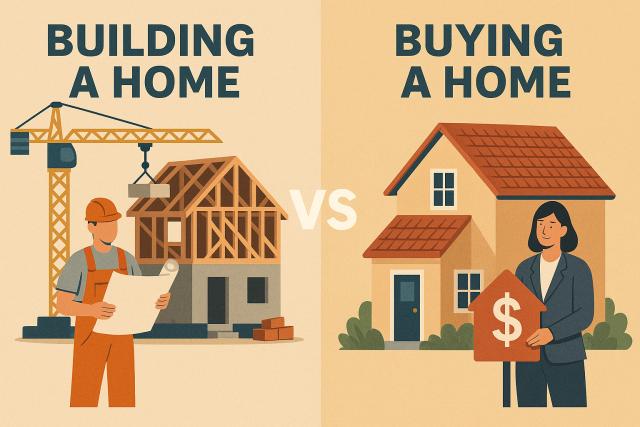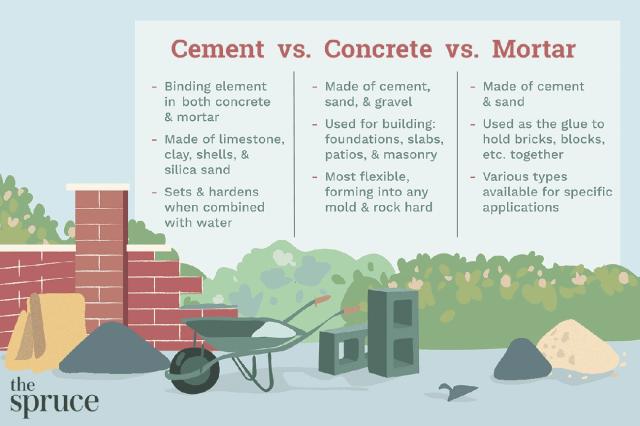
How to Get Rid of Carpenter Ants: Complete Guide for Home...
Carpenter ants rank among the largest and most destructive ants in the United States, measuring u...

Comparing building costs between new construction and existing homes in 2025 shows significant differences that affect your homeownership decisions. Current market data reveals that new construction averages $290-350 per square foot, while existing homes typically sell for $180-240 per square foot. These baseline figures provide a starting point, but they don't tell the complete story. The numbers above don't account for additional expenses that impact your total investment. Building comparisons show that while new construction offers customization and energy efficiency, existing homes often require unexpected repair costs reaching $15,000-30,000 in the first five years of ownership. Understanding these cost differences helps you make an informed decision between building from scratch or purchasing an established property. This guide breaks down all cost components, from foundation to finishing touches, helping you determine which option delivers the best value for your situation in 2025.
Construction costs in 2025 explain why many homebuyers experience sticker shock when pricing new builds. National Association of Home Builders (NAHB) data shows construction costs represent approximately 64.4% of a new home's total price, with finished lot costs adding another 13.7%. Understanding these costs helps you make informed decisions about whether to build or buy. The major expense categories determine your bottom line.
Your foundation supports everything else, making it crucial to get it right. Excavation typically ranges from $1,500 to $5,000, depending on terrain and accessibility. Foundation concrete work adds significantly more to your budget, costing between $4 and $7 per square foot.
|
Foundation Component |
Typical Cost Range |
|---|---|
|
Excavation |
$1,500 - $5,000 |
|
Concrete Foundation |
$8,000 - $14,000 (for a 2,000 sq ft home) |
|
Grading |
Included in the excavation |
Pro Tip: Never skimp on foundation quality—problems here become exponentially more expensive to fix later.
Once your foundation is complete, framing transforms your project from concept to reality. This stage accounts for a substantial portion of your construction budget.
Framing costs range from $20,000 to $50,000 based on home size and design complexity. Roofing adds another $5,000 to $15,000, with costs varying based on the materials chosen. Metal roofing costs more upfront but offers greater longevity than asphalt shingles.
Exterior finishes provide both protection and curb appeal. Siding costs between $3.17 and $6.19 per square foot, while windows range from $300 to $1,500 each, depending on size, style, and energy efficiency ratings.
Doors represent another significant expense, typically costing $500 to $2,500 each based on material and design. These exterior elements offer a strong return on investment through improved energy efficiency and enhanced resale value.
Essential systems behind your walls add considerable expense to new construction. Rough-in plumbing costs approximately $4.50 per square foot, while electrical wiring ranges from $4 to $9 per square foot. HVAC installation typically adds $5,000 to $9,000 to your budget.
Labor costs for specialized trades increase expenses further. Electricians and plumbers command premium rates, averaging $28.83 and $28.94 per hour, respectively, in 2025. Ongoing labor shortages in construction continue driving these costs upward.
Interior finishes account for approximately 24.1% of new home building costs, according to NAHB. For a $300,000 home, this translates to roughly $72,300 for elements like:
These costs can fluctuate dramatically based on your selections. While custom finishes increase upfront costs, they enhance resale value and reduce future replacement expenses.
Building permits start around $30 but can reach $1,737 depending on your location. These regulatory expenses vary significantly by region, making local research essential for accurate budgeting.

Professional home inspections provide your first line of defense against unexpected expenses, typically costing between $270 and $500. This upfront expense often uncovers issues that would otherwise remain hidden until after purchase.
|
Inspection/Repair Type |
Typical Cost Range |
|---|---|
|
General Home Inspection |
$270 - $500 |
|
Specialized Inspections (Roof, Foundation) |
$150 - $300 each |
|
Immediate Repairs (Average) |
$5,000 - $15,000 |
|
Major System Replacement (HVAC, Roof) |
$5,000 - $25,000 |
Pro Tip: Use inspection findings as negotiation tools. When the water heater needs replacement, the foundation requires work, or the house needs rewiring, you can often persuade sellers to address these costs or reduce the selling price.
Deferred maintenance represents repairs or upkeep that the previous owner postponed, making these issues your financial responsibility after purchase. A thorough evaluation before buying helps identify potential problems.
Consider these questions when examining an older home:
Energy inefficiency creates another ongoing expense in older homes. Properties built before modern efficiency standards typically lack upgraded insulation, modern HVAC systems, or energy-efficient windows. You could pay 20-30% more for heating and cooling compared to newly built properties.
These ongoing costs may eventually offset initial savings from choosing an existing home over new construction. Many buyers underestimate these monthly expenses that accumulate over time.
After purchasing an existing home, you'll likely want to make modifications to match your style and functional needs. These changes—from simple updates to major renovations—add considerably to your total investment.
Common modification expenses include:
These alterations should factor into your cost calculations when comparing options. New construction includes modern features from the start, while older properties often require significant investments to achieve comparable functionality.
Renovation projects in existing homes frequently exceed initial estimates by 10-25% due to unexpected complications discovered once walls are opened or systems accessed. This uncertainty makes budget planning more challenging compared to the predictable costs of new construction.
Labor costs represent nearly 40% of total construction expenses in 2025, making them a critical factor when comparing building versus buying options. The skilled workers who build your home significantly impact your budget through hourly rates, regional variations, and current market pressures. First-time builders often focus on material costs without fully accounting for the labor required to transform those materials into a finished home.
Hiring a general contractor costs approximately $22.08 per hour on average, but this base rate only tells part of the story. Specialized trades command substantially higher rates, with electricians and plumbers among the most expensive at $28.83 and $28.94 per hour, respectively. These rates add up to thousands of dollars throughout your build timeline.
|
Trade |
Average Hourly Rate |
|---|---|
|
General Contractor |
$22.08 |
|
Electrician |
$28.83 |
|
Plumber |
$28.94 |
|
Carpenter |
$24.58 |
|
HVAC Specialist |
$25.16 |
Best for: Focus on total project estimates rather than hourly rates alone when comparing bids. Some contractors work more efficiently, potentially making a higher hourly rate more economical in the long run.
Permit and inspection fees represent unavoidable regulatory costs that vary dramatically by location. Building permits typically start at $30 for basic projects, but comprehensive permits for new construction range from $270 to $1,737, depending on your region.
Northeast and West Coast regions generally impose the highest regulatory costs, while southern states typically offer more affordable permitting structures. These fees aren't negotiable—they represent fixed costs in your building budget that must be paid regardless of other cost-saving efforts.
First-time builders often underestimate these expenses, especially when comparing new construction to existing home prices that have already absorbed these regulatory costs.
The construction industry faces persistent labor shortages in 2025, particularly affecting specialized trades. Supply and demand principles continue driving labor costs upward across most regions.
These shortages cause scheduling delays that extend project timelines, indirectly increasing overall costs through extended construction loans and delayed occupancy. Competition for quality labor teams can result in premium pricing for your project in high-demand markets.
Labor market pressure is a significant consideration when comparing new construction to existing homes, as labor constraints can extend your project timeline by 20-30% compared to pre-pandemic scheduling expectations.
The numbers between new construction and existing homes tell different stories depending on how you analyze them. Understanding these differences enables you to make informed financial decisions based on your budget constraints and long-term objectives. The true cost comparison requires examining square footage pricing, land considerations, and total investment needed for both options.
Single-family new construction costs approximately $162 per square foot in 2025, after subtracting land investment and contractor overhead. This average fluctuates significantly based on several factors:
Existing homes typically sell at $140-155 per square foot in most markets, creating an apparent price advantage. This gap narrows when factoring in renovation costs and energy efficiency upgrades for older properties.
Pro Tip: When comparing per-square-foot costs, calculate based on finished living space only—unfinished basements or garage areas can skew the comparison and lead to inaccurate budgeting.
For new construction, the National Association of Home Builders (NAHB) reports that finished lot costs constitute approximately 13.7% of a new home's total sales price. For a $300,000 home, roughly $41,100 goes toward securing and preparing the land.
Land development expenses break down as follows:
|
Development Component |
Typical Percentage of Total Cost |
|---|---|
|
Raw Land Purchase |
8-10% |
|
Site Preparation |
1-2% |
|
Utility Connections |
2-3% |
|
Permits & Fees |
1-2% |
Existing homes have already absorbed these costs, though they often come with less optimal lot configurations or locations than newly developed properties.
The comprehensive price comparison between the two options shows:
|
Cost Factor |
New Construction |
Existing Home |
|---|---|---|
|
Median Price |
$323,026 (excluding land) |
$429,813 |
|
Closing Costs |
2-5% |
2-5% |
|
Immediate Repairs |
Minimal |
$5,000-$15,000 |
|
Energy Efficiency |
High |
Often Lower |
|
Maintenance (First 5 Years) |
Minimal |
$10,000-$20,000 |
|
Customization Costs |
Included |
Additional |
While existing homes typically show lower initial purchase prices, new construction often proves more economical long-term once you factor in repairs, maintenance, and energy costs. Warranty coverage on new homes provides financial protection during the early years of ownership that existing properties cannot match.
Deciding between building new or buying existing means weighing factors beyond upfront costs. Both options offer distinct advantages and challenges that affect your long-term satisfaction and financial outlook.
New construction provides modern efficiencies and customization that existing homes often cannot match. Brand-new systems mean reduced maintenance concerns for years to come. Many components include manufacturer warranties, covering appliances, roofing, and HVAC systems, providing financial protection against unexpected breakdowns.
|
Pros |
Cons |
|---|---|
|
Modern energy efficiency |
Extended construction timelines |
|
Warranty coverage included |
Budget uncertainty during build |
|
Full customization options |
Temporary housing costs |
|
Minimal maintenance for the first 5 years |
Decision fatigue from choices |
Pro Tip: When building new, catalog all warranty information in a digital folder for easy access when issues arise.
Purchasing an established property offers immediate occupancy and certainty about what you're getting. Unlike new construction plans, existing homes let you experience the actual living space before committing. Established neighborhoods typically offer mature landscaping and community amenities already in place.
|
Pros |
Cons |
|---|---|
|
Immediate occupancy |
Hidden problems beneath the surface |
|
Established neighborhoods |
Higher energy costs |
|
See the actual living space |
Outdated systems and insulation |
|
Lower upfront costs |
Ongoing repair expenses |
Choosing between new construction and existing homes requires balancing multiple factors beyond initial purchase price. While existing homes typically cost less upfront, this gap often narrows when you factor in renovation expenses and efficiency upgrades.
The hidden costs of older homes can accumulate quickly. Immediate repairs, deferred maintenance issues, and higher energy bills might offset your initial savings over five years of ownership. New construction may prove more economical in the long run despite higher initial investment.
Consider these key decision factors when making your choice:
Both options can provide excellent homeownership experiences when you understand their financial implications. Thorough research and realistic budgeting help you avoid surprises regardless of which path you choose.
Understanding the true costs of homeownership in 2025 requires looking beyond initial purchase prices to make informed financial decisions.
The key is calculating the total cost of ownership rather than focusing solely on purchase price, as both options can provide excellent value when properly planned and budgeted for your specific situation.
GET THE ESSENCE OF RELEVANT HOME
IMPROVEMENT TOPICS IN LESS THAN 5 MINUTES

How to Get Rid of Carpenter Ants: Complete Guide for Home...
Carpenter ants rank among the largest and most destructive ants in the United States, measuring u...

Concrete and cement rank among the most misunderstood terms in construction and home improvement....

Thanks for joining our homeowners’ community.
Stay tuned!
Choose the category
Choose the category